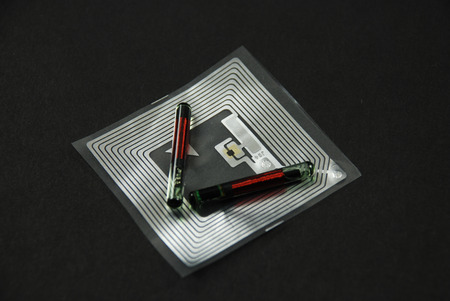
The year 1948 may not seem to ring many bells in our minds but it was the time for the formal introduction of a technology called radio frequency identification (RFID). It has impacted the consumer goods industry especially given that probably all retail and manufacturing transactions in the modern world rely on it. It is especially important in goods tracking and is a lynchpin in best practice as it provides consumer confidence in knowing the distribution and care given to a product as it passes through the retail system. That process which consumers generally do not see but is operated by retailers and manufacturers is supply chain management. It is now the main competitor to the barcoding system as a technology.
The Basic Technology
The four main features of an RFID system are a tag, the antenna, a reader of the tag, and a database to collect vital information. RFID tags are electronic devices that receive, store, and transmit data such as manufacturer codes, serial numbers, their country of origin, formulations and recipes, nutritional data, shelf-life and expiration dates, and a number of other features too numerous to mention. The RFID reader relies on a radio frequency transmitter and receiver linked to a control unit, and a memory device to obtain access to stored information for authentication. The antennae attached to both readers and tags enables the wireless exchange of information between these two parts.
Taking a more detailed look:-
The tag is a device composed of an electronic circuit with an integrated antenna, a portable memory using radio frequency to transfer data between the tag, the antenna and then the receiver. This type of device can be read-only or read-write. Two types are classified: the active sort because it has a battery and transmits its data, or a passive one which is activated by an external signal. At the moment, all the electronic componentry and circuitry is located on a silicon microchip but this may change as new technologies are introduced. The cost of the tag depends mainly on the surface area of the silicon chip and the antenna metal. The tags are not cheap costing about 6–10¢ each, making them cost-prohibitive for most primary food packages. They tend to be used on larger packaging such as palettes and high value goods.
The antenna which is connected to the chip is a critical link in the chain. It receives and transmits electromagnetic waves, resulting in wireless data transfer. The antenna is usually constructed by etching a thin film of copper or aluminum which is deposited on the surface of the substrate that underlies the tag. The chip and antenna are mounted on a substrate made of paper or plastic that is rigidly fixed to the packaging.
The external reader in the store, warehouse, and administrative site communicates with the tag via the antenna. It converts and interprets radio waves into digital information and receives commands from the application software. Additionally, the reader may send its power to passive tags as part of the activating process.
The data handling computer can read and write information both from and to the tags through the reader. It stores and evaluates the obtained data and links the transceiver to application software. In current circles it is perhaps the most costly item and requires a high capital investment, since it must be installed at every site. Cheaper versions read transmissions from powered or active tags. Thinking ahead, it might be feasible for miniature readers on every store shelf and home shelf to even more closely track packages. Data from the readers including the location, identification, status, amongst other features may be instantly operated upon as part of a marketing tool to check for a consumer’s interest and reaction to a product.
Advantages Over Barcoding
RFID has several advantages over the barcoding system. RFID has a higher data holding capacity and the ability to read several tags almost simultaneously. In ideal conditions, RFID does not require line of sight but in reality the conditions for RFID are difficult because of high levels of electronic interference, the reading range may be limited, as is its readability and depth of penetration. The scope of use of RFID now means that with the appropriate hardware, these can be used to tag herding animals and so monitor their welfare (see article).
Impact On Product Shelf-Life
The product shelf-life is an important consumer factor in purchasing and enjoyment of a product following its storage and then consumption. RFID is able to provide data especially when a product fails to live up to expectations or when more serious situations arise such as product recalls. There is an emerging technology linking RFID with oxygen and humidity sensors, biosensors and other techniques which can monitor quality changes or microbial spoilage within a product. Examples also exist where medical foods have been suggested for patients with illness that need suitable nutrition. RFID preserves consumer satisfaction and confidence by protecting against counterfeit products by assuring product origin.
Review Articles
There are a series of excellent review articles on the subject which are worth consulting as they provide much more detailed insights into the current status of the technology and its vast potential. The most notable are those by Kumar et al., (2009) which gives a very strong overview of the industry. Many of the applications it cites have been superseded but its worth looking at the citations to get a measure of how valuable the technology has become. A slightly older review (Brody et al., 2008) puts RFID into context with other intelligent food packaging technologies.
References
Brody, A. L., Bugusu, B., Han, J. H., Sand, C. K. and McHugh, T. H. (2008), Scientific Status Summary. J. Food Sci., 73: R107–R116. doi:10.1111/j.1750-3841.2008.00933.x
Kumar, P., Reinitz, H.W., Simunovic, J., Sandeep, K.P. and Franzon, P.D. (2009), Overview of RFID Technology and Its Applications in the Food Industry. J. Food Sci., 74: R101–R106. doi:10.1111/j.1750-3841.2009.01323.x
Leave a Reply